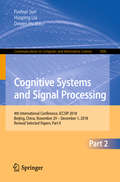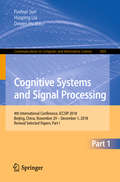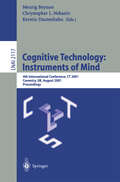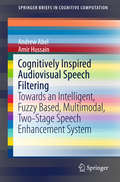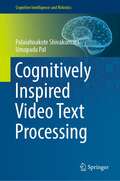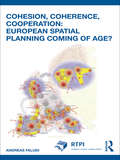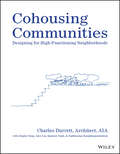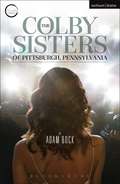- Table View
- List View
Cognitive Systems and Signal Processing: 4th International Conference, ICCSIP 2018, Beijing, China, November 29 - December 1, 2018, Revised Selected Papers, Part II (Communications in Computer and Information Science #1006)
by Fuchun Sun Huaping Liu Dewen HuThis two-volume set (CCIS 1005 and CCIS 1006) constitutes the refereed proceedings of the 4th International Conference on Cognitive Systems and Signal Processing, ICCSIP2018, held in Beijing, China, in November and December 2018.The 96 revised full papers presented were carefully reviewed and selected from 169 submissions. The papers are organized in topical sections on vision and image; algorithms; robotics; human-computer interaction; deep learning; information processing and automatic driving.
Cognitive Systems and Signal Processing: 4th International Conference, ICCSIP 2018, Beijing, China, November 29 - December 1, 2018, Revised Selected Papers, Part I (Communications in Computer and Information Science #1005)
by Fuchun Sun Huaping Liu Dewen HuThis two-volume set (CCIS 1005 and CCIS 1006) constitutes the refereed proceedings of the 4th International Conference on Cognitive Systems and Signal Processing, ICCSIP2018, held in Beijing, China, in November and December 2018.The 96 revised full papers presented were carefully reviewed and selected from 169 submissions. The papers are organized in topical sections on vision and image; algorithms; robotics; human-computer interaction; deep learning; information processing and automatic driving.
Cognitive Techniques in Visual Data Interpretation (Studies in Computational Intelligence #228)
by Lidia OgielaThe extremely rapid progress of science dealing with the design of new computer systems and the development of intelligent algorithmic solutions for solving c- plex problems has become apparent also in the field of computational intelligence and cognitive informatics methods. The progress of these new branches of inf- matics has only started a few years ago, but they are already making a very s- nificant contribution to the development of modern technologies, and also forming the foundations for future research on building an artificial brain and systems i- tating human thought processes. We are already able to build robots with basic machine intelligence, which can sometimes perform complex actions and also - erate by adapting to changing conditions of their surroundings. This very impr- sive development of intelligent systems is manifested in the creation of robotic devices which use artificial intelligence algorithms in their operations, mo- ments, when solving difficult problems or communicating with humans. It is also evidenced by the introduction of new methods of reasoning about and interpreting objects or events surrounding the system. One of the fields in which the need to deploy such modern solutions is obvious are cognitive vision systems used both in mobile robots and in computer systems which recognise or interpret the meaning of recorded signals or patterns.
Cognitive Technology: 4th International Conference, CT 2001 Coventry, UK, August 6-9, 2001 Proceedings (Lecture Notes in Computer Science #2117)
by Meurig Beynon Chrystopher L. Nehaniv Kerstin DautenhahnCognitive Technology: Instruments of Mind Cognitive Technology is the study of the impact of technology on human cog- tion, the externalization of technology from the human mind, and the pragmatics of tools. It promotes the view that human beings should develop methods to p- dict, analyse, and optimize aspects of human-tool relationship in a manner that respects human wholeness. In particular the development of new tools such as virtual environments, new computer devices, and software tools has been too little concerned with the impacts these technologies will have on human cog- tive and social capacities. Our tools change what we are and how we relate to the world around us. They need to be developed in a manner that both extends human capabilities while ensuring an appropriate cognitive t between organism and instrument. The principal theme of the CT 2001 conference and volume is declared in its title: Instruments of Mind. Cognitive Technology is concerned with the interaction between two worlds: that of the mind and that of the machine. In science and engineering, this - teraction is often explored by posing the question: how can technology be best tailored to human cognition? But as the history of technological developments has consistently shown, cognition is also fashioned by technology. Technologies as diverse as writing, electricity generation, and the silicon chip all illustrate the profound and dynamic impact of technology upon ourselves and our conceptions of the world.
Cognitive Theory and Documentary Film
by Catalin Brylla Mette KramerThis groundbreaking edited collection is the first major study to explore the intersection between cognitive theory and documentary film studies, focusing on a variety of formats, such as first-person, wildlife, animated and slow TV documentary, as well as docudrama and web videos. Documentaries play an increasingly significant role in informing our cognitive and emotional understanding of today’s mass-mediated society, and this collection seeks to illuminate their production, exhibition, and reception. Taking an interdisciplinary approach, the essays draw on the latest research in film studies, the neurosciences, cultural studies, cognitive psychology, social psychology, and the philosophy of mind. With a foreword by documentary studies pioneer Bill Nichols and contributions from both theorists and practitioners, this volume firmly demonstrates that cognitive theory represents a valuable tool not only for film scholars but also for filmmakers and practice-led researchers.
Cognitive Theory and Documentary Film
by Catalin Brylla Mette KramerThis groundbreaking edited collection is the first major study to explore the intersection between cognitive theory and documentary film studies, focusing on a variety of formats, such as first-person, wildlife, animated and slow TV documentary, as well as docudrama and web videos. Documentaries play an increasingly significant role in informing our cognitive and emotional understanding of today’s mass-mediated society, and this collection seeks to illuminate their production, exhibition, and reception. Taking an interdisciplinary approach, the essays draw on the latest research in film studies, the neurosciences, cultural studies, cognitive psychology, social psychology, and the philosophy of mind. With a foreword by documentary studies pioneer Bill Nichols and contributions from both theorists and practitioners, this volume firmly demonstrates that cognitive theory represents a valuable tool not only for film scholars but also for filmmakers and practice-led researchers.
Cognitive Vision: 4th International Workshop, ICVW 2008, Santorini, Greece, May 12, 2008, Revised Selected Papers (Lecture Notes in Computer Science #5329)
by Markus VinczeWeareverypleasedtopresenttheproceedingsofthe4thInternationalCognitive Vision Workshop,held as part of the 6th InternationalConference on Computer Vision Systems on Santorini,Greeceduring May12–15,2008.The aim of ICVW 2008 was to document the progress of the relatively young ?eld of cognitive computer vision, bringing together researchers working and interested in this ?eld and giving them a platform to discuss the results of the di?erent European cognitive vision projects as well as international projects in this area. Original research papers were solicited in all aspects of cognitive vision, targeting the following areas in particular: – Memory: The coupling between visual perception, tasks, knowledge and the visualsystemrequiresmemory.Issuesthatareofspecialimportanceforin- grating memory into vision systems include: how to manage representations with limited resources;modelfor attention;integrationofinformationacross representations and time. – Learning and Adaptation: A system whose goal is that of interacting with the real world must be capable of learning from experience and adapting to unexpected changes. Also, there is a need for integration of multiple - sual features to enable generation of stable hypotheses, and for methods for combination of cues in the presence of uncertainty. – Categorization: Research has in particular focused on recall of speci?c - ject instances, events and actions. Whereas recently some progress has been achieved in systems that allow limited recognition of object classes, events and scenes across visual appearance, new methods are needed to enable abstractions and e?ective categorization across variations in color, surface markings, geometry, temporal scenes, context and tasks.
Cognitive Vision Systems: Sampling the Spectrum of Approaches (Lecture Notes in Computer Science #3948)
by Henrik I. Christensen Hans-Hellmut NagelThis volume is a post-event proceedings volume and contains selected papers based on the presentations given, and the lively discussions that ensued, during a seminar held in Dagstuhl Castle, Germany, in October 2003. Co-sponsored by ECVision, the cognitive vision network of excellence, it was organized to further strengthen cooperation between research groups from different countries working in the field of cognitive vision systems.
Cognitively Inspired Audiovisual Speech Filtering: Towards an Intelligent, Fuzzy Based, Multimodal, Two-Stage Speech Enhancement System (SpringerBriefs in Cognitive Computation #5)
by Andrew Abel Amir HussainThis book presents a summary of the cognitively inspired basis behind multimodal speech enhancement, covering the relationship between audio and visual modalities in speech, as well as recent research into audiovisual speech correlation. A number of audiovisual speech filtering approaches that make use of this relationship are also discussed. A novel multimodal speech enhancement system, making use of both visual and audio information to filter speech, is presented, and this book explores the extension of this system with the use of fuzzy logic to demonstrate an initial implementation of an autonomous, adaptive, and context aware multimodal system. This work also discusses the challenges presented with regard to testing such a system, the limitations with many current audiovisual speech corpora, and discusses a suitable approach towards development of a corpus designed to test this novel, cognitively inspired, speech filtering system.
Cognitively Inspired Video Text Processing (Cognitive Intelligence and Robotics)
by Umapada Pal Palaiahnakote ShivakumaraAs technologies are fast advancing, the importance of text detection and recognition is receiving special attention from the researchers. Thus, one can see several real-time applications of video text processing which requires cognitive-based methods to find a solution. The main applications are (1) retrieving and indexing video based on semantic of the content of the video, (2) machine translation to assist foreigners, (3) assisting blind people to walk on the road freely without aid, (4) automatic vehicle driving, (5) license plate tracing to catch vehicles which violate the traffic signals, (6) monitoring the images posted on social media based on text and content of the images, (7) identifying the location based on the address of the street and shops, etc., (8) tracing players in the sports based on the jersey/bib number or text, and (9) in the same way, tracing the bib number in case of marathon and other events. For the above-mentioned applications, text detection and recognition in video and natural scene images is an integral part of the system.
The Coherence of EU Regional Policy: Contrasting Perspectives on the Structural Funds (Regions and Cities #Vol. 16)
by John Bachtler Ivan TurokThis book brings together a rich selection of up-to-date practical experience of EU regional policy from across Europe. It provides different perspectives on the design and operation of regional development strategies under the Structural Funds, from people closely involved in studying, managing or advising on the process at EU, national and regional levels. It therefore offers a more comprehensive and detailed understanding of the structural policies than has been available hitherto. This will prove particularly useful to researchers, practitioners and students interested in European regional policies and processes.
The Coherence of EU Regional Policy: Contrasting Perspectives on the Structural Funds (Regions and Cities)
by John Bachtler Ivan TurokThis book brings together a rich selection of up-to-date practical experience of EU regional policy from across Europe. It provides different perspectives on the design and operation of regional development strategies under the Structural Funds, from people closely involved in studying, managing or advising on the process at EU, national and regional levels. It therefore offers a more comprehensive and detailed understanding of the structural policies than has been available hitherto. This will prove particularly useful to researchers, practitioners and students interested in European regional policies and processes.
Cohesion, Coherence, Cooperation: European Spatial Planning Coming of Age? (RTPI Library Series)
by Andreas FaludiSince its foundation the European Union has gradually developed policies that are aimed at achieving increased economic and social cohesion. This book examines the most recent of these, the concept of territorial cohesion. Territorial cohesion is the pursuit of balanced development, competitiveness, sustainable development, and good governance. These concerns are most readily addressed by the formulation of spatial strategies under the umbrella of spatial planning, that brings together a multitude of public and private actors in a process that requires cohesion, coherence and co-operation. This book traces the development of spatial planning at European level and argues that spatial planning can become a vehicle, not only for territorial cohesion, but for EU policy generally.
Cohesion, Coherence, Cooperation: European Spatial Planning Coming of Age? (RTPI Library Series)
by Andreas FaludiSince its foundation the European Union has gradually developed policies that are aimed at achieving increased economic and social cohesion. This book examines the most recent of these, the concept of territorial cohesion. Territorial cohesion is the pursuit of balanced development, competitiveness, sustainable development, and good governance. These concerns are most readily addressed by the formulation of spatial strategies under the umbrella of spatial planning, that brings together a multitude of public and private actors in a process that requires cohesion, coherence and co-operation. This book traces the development of spatial planning at European level and argues that spatial planning can become a vehicle, not only for territorial cohesion, but for EU policy generally.
Cohesion in Film: Tracking Film Elements
by C. TsengThis book presents a new approach to film analysis. It provides methods for analysing meaning making in film through tracking concrete details of film images such as characters, objects, settings and character action. It also represents new ground for investigating empirical issues in film.
Cohousing Communities: Designing for High-Functioning Neighborhoods
by Charles DurrettExplore a groundbreaking and holistic new approach to designing community-first neighborhoods In Cohousing Communities: Designing for High-Functioning Neighborhoods, distinguished architect and affordable housing advocate Charles Durrett delivers a complete, start-to-finish guide for designing anything where the emphasis lies with the community. This book describes the consequential role that architecture and a healthy design process can play in the success of neighborhoods, churches, towns, and more. It’s an inspiring collection of ideas that prioritize high-functioning neighborhoods. In the book, the author draws on the success of hundreds of community-first projects to show readers how to design a project that addresses both timeless and modern challenges—from aging to climate change and racism—in its architecture and urban design. He compiles facts and concepts that are essential to the design of a high-functioning community, where people can participate in a way that reflects their values, improves their social connections, and retain their autonomy and privacy. Readers will also find: Ideas for town planning, street planning, and other town altering improvements Discussions of how developers can make better multifamily housing Explorations of how planners and politicians can make high-functioning neighborhoods a cornerstone of their community In-depth treatments of families who want to confirm that they’re choosing the right neighborhood Perfect for university students and professors who strive to see new ways to create neighborhoods, Cohousing Communities: Designing for High-Functioning Neighborhoods will also appeal to universities planning new neighborhoods for retired alumni or new housing for students and faculty. Praise for Charles Durrett and Cohousing Communities: “…Get and read Cohousing Communities… Read it from the front cover to the back cover. It’s The Bible of Cohousing. And, like The Bible, it needs to be STUDIED not just read. Mark it up w/ your questions. Highlight, underline, write in the margins, fold the corners… This way you will gather your understanding how building cohousing gets “done," create your pathway to “Getting It Built”… and, most importantly get everyone on the same page for working together.” -- Ann Zabaldo, Executive Director, Mid Atlantic Cohousing
Cohousing Communities: Designing for High-Functioning Neighborhoods
by Charles DurrettExplore a groundbreaking and holistic new approach to designing community-first neighborhoods In Cohousing Communities: Designing for High-Functioning Neighborhoods, distinguished architect and affordable housing advocate Charles Durrett delivers a complete, start-to-finish guide for designing anything where the emphasis lies with the community. This book describes the consequential role that architecture and a healthy design process can play in the success of neighborhoods, churches, towns, and more. It’s an inspiring collection of ideas that prioritize high-functioning neighborhoods. In the book, the author draws on the success of hundreds of community-first projects to show readers how to design a project that addresses both timeless and modern challenges—from aging to climate change and racism—in its architecture and urban design. He compiles facts and concepts that are essential to the design of a high-functioning community, where people can participate in a way that reflects their values, improves their social connections, and retain their autonomy and privacy. Readers will also find: Ideas for town planning, street planning, and other town altering improvements Discussions of how developers can make better multifamily housing Explorations of how planners and politicians can make high-functioning neighborhoods a cornerstone of their community In-depth treatments of families who want to confirm that they’re choosing the right neighborhood Perfect for university students and professors who strive to see new ways to create neighborhoods, Cohousing Communities: Designing for High-Functioning Neighborhoods will also appeal to universities planning new neighborhoods for retired alumni or new housing for students and faculty. Praise for Charles Durrett and Cohousing Communities: “…Get and read Cohousing Communities… Read it from the front cover to the back cover. It’s The Bible of Cohousing. And, like The Bible, it needs to be STUDIED not just read. Mark it up w/ your questions. Highlight, underline, write in the margins, fold the corners… This way you will gather your understanding how building cohousing gets “done," create your pathway to “Getting It Built”… and, most importantly get everyone on the same page for working together.” -- Ann Zabaldo, Executive Director, Mid Atlantic Cohousing
Coin Collecting For Dummies
by Neil S. BermanDiscover a new hobby—or refine your existing techniques—with this practical coin collecting handbook In Coin Collecting For Dummies, professional rare coin dealer Neil Berman delivers a hands-on and fun guide to the intriguing hobby of numismatics—also known as coin collection! You'll learn how to buy, sell, grade, value, handle, and store your coins, as well as how to decide what kind of coins you should collect and how to assemble or diversify your collection. In this book, you'll also find out how to: Evaluate coins based on their age, condition, rarity, and more Navigate and make use of auction houses that deal in the buying and selling of rare coins Make the most of your new hobby by learning where to find rare coins and how to complete your collections There's no one "right" way to collect coins. But Coin Collecting For Dummies will show you how to avoid the most common pitfalls and take advantage of some handy tips, tricks, and best practices that make collecting coins even more fun and exciting. Perfect for the novice collector, or seasoned veterans looking for the latest news in coin grading and history, this book is a must-read for anyone interested in the fascinating world of coin collection.
Coin Collecting For Dummies
by Neil S. BermanDiscover a new hobby—or refine your existing techniques—with this practical coin collecting handbook In Coin Collecting For Dummies, professional rare coin dealer Neil Berman delivers a hands-on and fun guide to the intriguing hobby of numismatics—also known as coin collection! You'll learn how to buy, sell, grade, value, handle, and store your coins, as well as how to decide what kind of coins you should collect and how to assemble or diversify your collection. In this book, you'll also find out how to: Evaluate coins based on their age, condition, rarity, and more Navigate and make use of auction houses that deal in the buying and selling of rare coins Make the most of your new hobby by learning where to find rare coins and how to complete your collections There's no one "right" way to collect coins. But Coin Collecting For Dummies will show you how to avoid the most common pitfalls and take advantage of some handy tips, tricks, and best practices that make collecting coins even more fun and exciting. Perfect for the novice collector, or seasoned veterans looking for the latest news in coin grading and history, this book is a must-read for anyone interested in the fascinating world of coin collection.
Coin Collecting For Dummies
by Neil S. Berman Ron GuthCan’t make heads or tails out of coin collecting? You need Coin Collecting For Dummies, 2nd Edition, the treasure trove on information on numismatics. This hands-on guide escorts you through the world’s oldest hobby, helping you decide which type of coins you want to collect, keep your collection in mint condition, buy and sell coins on the Internet, find interesting coin shows to attend, and assemble and diversify a great collection. The purpose of this fun, easy-to-access guide is to turn you into a world-class coin collector in as little time as possible. You’ll learn what coins can teach you about history and geography, develop organizational and observational skills, and learn to use analytical tools, all without event thinking about it. And you’ll learn the basics about ancient coins, U.S. coins, world coins, and the wild-and-wooly stuff that really gets your numismatic juices flowing. Discover how to: Start your collection correctly Evaluate coins using age, condition, rarity, and more Buy interesting coins without breaking the bank Locate rare and expensive coins Get savvy about avoiding fakes Get the whole family involved in your collection Develop a buying strategy Clean and handle coins safely Keep your collection secure at home and on the road Investigate tokens, medals, and miscellaneous coins Create complete collections of copper, nickel, silver, or gold U.S. coins When it comes to numismatics, Coin Collecting For Dummies, 2nd Edition is right on the money!
Coin Collecting For Dummies
by Neil S. Berman Ron GuthCan’t make heads or tails out of coin collecting? You need Coin Collecting For Dummies, 2nd Edition, the treasure trove on information on numismatics. This hands-on guide escorts you through the world’s oldest hobby, helping you decide which type of coins you want to collect, keep your collection in mint condition, buy and sell coins on the Internet, find interesting coin shows to attend, and assemble and diversify a great collection. The purpose of this fun, easy-to-access guide is to turn you into a world-class coin collector in as little time as possible. You’ll learn what coins can teach you about history and geography, develop organizational and observational skills, and learn to use analytical tools, all without event thinking about it. And you’ll learn the basics about ancient coins, U.S. coins, world coins, and the wild-and-wooly stuff that really gets your numismatic juices flowing. Discover how to: Start your collection correctly Evaluate coins using age, condition, rarity, and more Buy interesting coins without breaking the bank Locate rare and expensive coins Get savvy about avoiding fakes Get the whole family involved in your collection Develop a buying strategy Clean and handle coins safely Keep your collection secure at home and on the road Investigate tokens, medals, and miscellaneous coins Create complete collections of copper, nickel, silver, or gold U.S. coins When it comes to numismatics, Coin Collecting For Dummies, 2nd Edition is right on the money!
Coin Finds in Britain: A Collector’s Guide (Shire Library #746)
by Michael CuddefordOver the centuries Britain's soil has yielded countless spectacular hoards of ancient coins and other artefacts, affording us priceless insights into our ancestors' lives – and it is not only such large finds that await discovery but also many thousands of individual pieces. Wonderfully, discoveries both minor and momentous are frequently made not by teams of professionals but by amateur archaeologists and metal-detector enthusiasts, for whom this book is intended as a helpful companion. It provides a catalogue of commonly encountered coins, dating from ancient times until the modern day, explaining their historical context, how they might have come to be lost and where they may be found today.
Coin Finds in Britain: A Collector’s Guide (Shire Library)
by Michael CuddefordOver the centuries Britain's soil has yielded countless spectacular hoards of ancient coins and other artefacts, affording us priceless insights into our ancestors' lives – and it is not only such large finds that await discovery but also many thousands of individual pieces. Wonderfully, discoveries both minor and momentous are frequently made not by teams of professionals but by amateur archaeologists and metal-detector enthusiasts, for whom this book is intended as a helpful companion. It provides a catalogue of commonly encountered coins, dating from ancient times until the modern day, explaining their historical context, how they might have come to be lost and where they may be found today.
The Colby Sisters of Pittsburgh, Pennsylvania (Modern Plays)
by Adam BockNobody knows us. They think they do. But they don't.In a world of champagne and canapés, the five Colby sisters are the glamorous faces of New York high society. With wealth, style and desirable husbands, they appear to have it all. But privately, the sisters' squabbles distort the picture of this perfect family. Image is everything and struggling to maintain it could have life-changing consequences.This black comedy by OBIE award-winning Canadian playwright Adam Bock received its world premiere at the Tricycle Theatre, London, on 19 June 2014.
The Colby Sisters of Pittsburgh, Pennsylvania (Modern Plays)
by Adam BockNobody knows us. They think they do. But they don't.In a world of champagne and canapés, the five Colby sisters are the glamorous faces of New York high society. With wealth, style and desirable husbands, they appear to have it all. But privately, the sisters' squabbles distort the picture of this perfect family. Image is everything and struggling to maintain it could have life-changing consequences.This black comedy by OBIE award-winning Canadian playwright Adam Bock received its world premiere at the Tricycle Theatre, London, on 19 June 2014.
